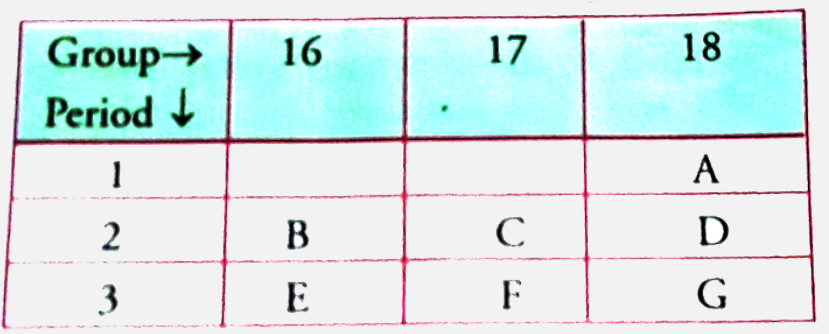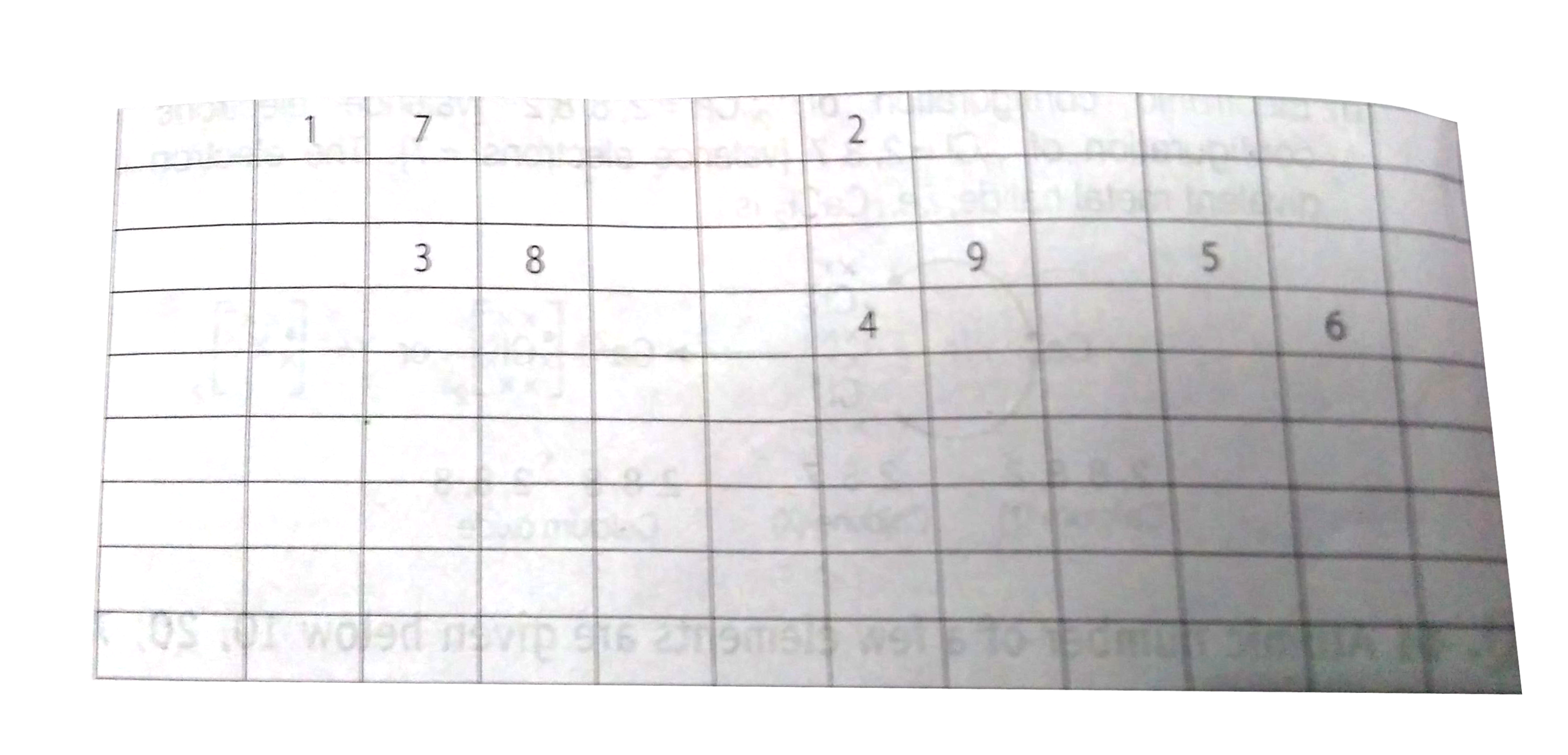Complete Solutions to Long Answer Questions of chapter PERIODIC CLASSIFICATION OF ELEMENTS of Class 10 book with complete answers and questions
| Class 10 | CHEMISTRY |
| Chapter | PERIODIC CLASSIFICATION OF ELEMENTS |
| DINESH CHEMISTRY | Long Answer Questions |
| Number Of Questions | 26 |
| Academic Year | 2023-24 |
Three elements A, B and C have atomic numbers 7, 8 and 9 respectively.
(a) What would be their positions in the modern periodic table ? (Mention group and period both)
(b) Arrange A, B and C in decreasing order of their size.
(c) Which one of the three elements is most reactive and why ?03:36View SolutionThe elements with atomic number 3 to 10 belong to the second period. Taking into account the trends in the general periodic properties, predict.
(a) The most electronegative element
(b) The most electropositive element
(c) The element belonging to noble gas family
(d) The element which constitutes large number of organic compounds.
(e) The element most abundant in air04:19View SolutionElements in Periodic Table show periodicity of properties''. List any four properties.
03:17View SolutionThe electronic configuration of three clements X, Y and Z are given below ,
X = 2 , Y = 2, 6 , Z = 2, 8, 2.
(i) Which element belongs to the second period ? (ii) Which element belongs to the eighteenth group ?
(iii) Which element belongs to the second group ? (iv) What is the valency of Y ?
(v) Are Y and Z metals or non-metals ?03:02View SolutionThe atomic numbers of elements A, B, C, D and E are given below :

From the above table, answer the following questions -
(a) Which two elements are chemically similar ? (b) Which is an inert gas ?
(c) Which element belongs to `3^(rd)` period of periodic table ? (d) Which element among these is a non-metal ?12:11View SolutionUsing the part of the periodic table given below, answer the questions that follow.

(i) Na has physical properties similar to which elements and why ?
(ii) Write the electronic configuration of N and P.
(iii) State one property common to fluorine and chlorine.09:05View SolutionThe atomic radii of the elements of second period are given below:

(a) Arrange these elements in the decreasing order of their atomic radii (Keeping the element with the largest atomic radius first).
(b) Are the elements now arranged in the pattern of a period in the periodic table?
(c) Which elements have the largest and the smallest atoms?
(d) From this data, infer how the atomic size (or atomic radius) of the elements changes as you go from left to right in a period?04:59View Solution'The atomic number of Cl is 17. On the basis of this information, answer the questions that follow :
(a) Write the electronic configuration of Cl.
(b) Find its valency.
(c) To which group does it belong ?
(d) Identify the type of ion it will form.
(e) Write down the formula of the compound it forms with other elements.03:02View SolutionThe list of the elements present in the same period but in different groups is given :
12 13 14 15 16 17 18
(a) Do these groups represent modern periodic table ?
(b) Which element will belong to oxygen family ?
(c) Which element will not take part in chemical combination ?
(d) The elements belonging to which groups will form ionic bonds most readily ?04:51View SolutionAn element E has following electronic configuration :
`{:(K,L,M,),(2,8,6,):}`
(a) To which group of the periodic table does element E belong ?
(b) To which period of the periodic table does element E belong ?
(c) State the number of valence electrons present in element E.
(d) State the valency of the element E.01:30View SolutionFrom the part of the periodic table given, answer the following questions.

(a) Which is the most reactive metal ? (b) Name the family of L, Q, R, T.
(c) Name one element of group 2 and 15, (d) Name one member of group 18 other than neon. (e) Give the name of the element S placed below carbon in group 14.11:08View SolutionAtomic number of an element is 16. Predict.
(i) the number of valence electrons in its atom (ii) its valency
(iii) its group number (iv) whether it is a metal or a non-metal
(v) the nature of oxide formed by it. (vi) the formula of the chloride.03:04View Solution(a) How are the following related ?
(i) Number of valence electrons of the different elements present in the same group.
(ii) Number of the shells of the elements in the same period.
(b) How do the following change ?
(i) Number of shells of the elements as we go down a group.
(ii) Number of valence electrons of elements on moving from left to right in a period.
(iii)Atomic radius in moving from left to right along a period.
(iv) Atomic size down a group.12:43View SolutionThe position of some elements A, B, C, D, E, F, and G in the Modern Periodic Table is given as under.

(a) In which group are inert elements placed ?
(b) What type of ions would B, C, E, and F form ?
(c) Which element would have chemical properties similar to C ?
(d) How many shells can A have ?
(e) What is the similarity between A and D ?
(f) Identify the most abundant element in the earth's crust.08:28View Solution(a) The modern periodic table has been evolved through the early attempts of Dobereiner, Newland and Mendeleev. List one advantage and one limitation of all the three attempts.
(b) Name the scientist who first of all showed that atomic number of an element is a more fundamental property than its atomic mass.
State Modern periodic law.08:02View SolutionAn element is placed in `2^("nd")` group and `3^("rd")` period of the periodic table, burns is presence of xygen of form a basic oxide
(a) Identify the element
(b) Write the electronic configuration
(c) Write a balanced equation when it burns in the presence of air
(d) Write a balanced when this oxide is dissolved in water
(e) Draw the electron dot structure for the formation of this oxide.06:17View SolutionAn element X (atomic number 17) reacts with an element Y (atomic number 20) to form a divalent halide
(a) Where in the periodic table are elements X and Y placed ?
(b) Classify X and Y as metal (s), non-metal (s) or metalloid (s)
(c) What will be the nature of oxide of element Y ? Identify the nature of bonding in the compound formed
(d) Draw the electron dot structure of the divalent halide.07:08View SolutionAtomic number of few elements are given below 10, 20, 7, 14
(a) Identify the elements
(b) Identify the group number of these elements in the periodic table
(c) Identify the periods of these elements in the periodic table
(d) What would be the electronic configuration for each of these elements
(e) Determine the valency of these elements.06:28View Solution(a) In this ladder (Figure) symbols of elements are jumbled up. Rearrange these symbols of elements in the increasing order of their atomic numbers in the periodic table
(b) Arrangement them in the order of their group also
 .05:50View Solution
.05:50View SolutionComplete the following crossword puzzle (Figure)
Across
(1) An element with atomic number 12
(3) Metal used in making cans and member of group 14
(4) A lustrous non-metal which has 7 electrons in its outermost shell
Down
(2) Highly reactive and soft metal which imparts yellow colour when subjected to flame and is kept in kerosene
(5) The first element of second period
(6) An element whihc is used in making flurescent bulbs and is second member of group 18 in the modern periodic table
(7) A radioactive element which is the last member of halogen family
(8) Metal which is an important constituent of steel and forms rust when exposed to moist air
(9) The first metalloid in modern periodic table whose fibres are used in making bullet-proof vests
 09:28View Solution
09:28View SolutionMendeleev predicted the existence of certain elements not known at that time and named two of them as Eka-Silicon and Eka-aluminium
(a) Name the elements which have taken the place of these elements
(b) Mention the group and the period of these electron in the modern periodic table
(c) Classify these elements as metals, non-metals or metalloids
(d) How many valence electrons are present in each one of them ?05:43View Solution(a) Electropositive nature of the element(s) increases down the group and decreases across the period
(b) Electronegativity of the element decreases down the group and increases across the period
(c) Atomic size increase down the group and decreases across a period (left to right)
(d) Metallic character increases down the group and decreases across a period
On the basis of the above trends of the periodic table, answer the following about the electron with atomic number 3 to 9
(a) Name the most electropositive element among them
(b) Name the most electronegative element
(c) Name of the element with smallest atomic size
(d) Name the element which is a metalloid
(e) Name the element which shows maximum valency.09:38View SolutionAn element X which is a yellow solid at room temperature shows catenation and allotropy. X forms two oxides which are also formed during the thermal decomposition of ferrous sulphate crystals and are the major air pollutants
(a) Identify the element X
(b) Write the electronic configuration of X
(c) Write the balanced chemical equation for the thermal decomposition of ferrous sulphate crystals ?
(d) What would be the nature (acidic/basic) of oxides formed ?
(e) Locate the position of the element in the modern table.07:37View SolutionAn element X of group 15 exists as diatomic molecule and combines with hydrogen at 773 K in presence of the catalyst to form a compound, ammonia which has a characteristic pungent smell
(a) Identify the element X. How many valence electrons does it have ?
(b) Draw the electron dot structure of the diatomic molecule of X. What type of bond is formed in it ?
(c) Draw the electron dot structure for ammonia and what type of bond is formed in it ?07:12View SolutionWhich group of elements could be placed in mendeleev's periodic table without disturbing the original order ? Give reason.
04:45View SolutionGive an account of the process adopted by Mendeleev for the classification of elements. How did he arrive at ''periodic law'' ?
04:36View Solution
Long Answer Questions questions and complete solutions for chapter PERIODIC CLASSIFICATION OF ELEMENTS of S DINESH & CO CHEMISTRY (HINGLISH) of Class 10
All Exercises from DINESH CHEMISTRY Class 10 CHEMISTRY PERIODIC CLASSIFICATION OF ELEMENTS
- Example
- HIGHER ORDER THINKING SKILL BASED QUESTIONS
- Long Answer Questions
- N.C.E.R.T. END EXERCISE
- N.C.E.R.T. IN TEXT PROBLEMS
- NCERT Exemplar Problems (Multiple Choice Questions)
- PBQs
- SAQs
- Short Ansewer Questions
- Test Your Knowledge (Long Answer Questions)
- Test Your Knowledge (Short Answer Questions)
- Test Your Knowledge (Very Short Answer Questions)
- Very Short Answer Questions
